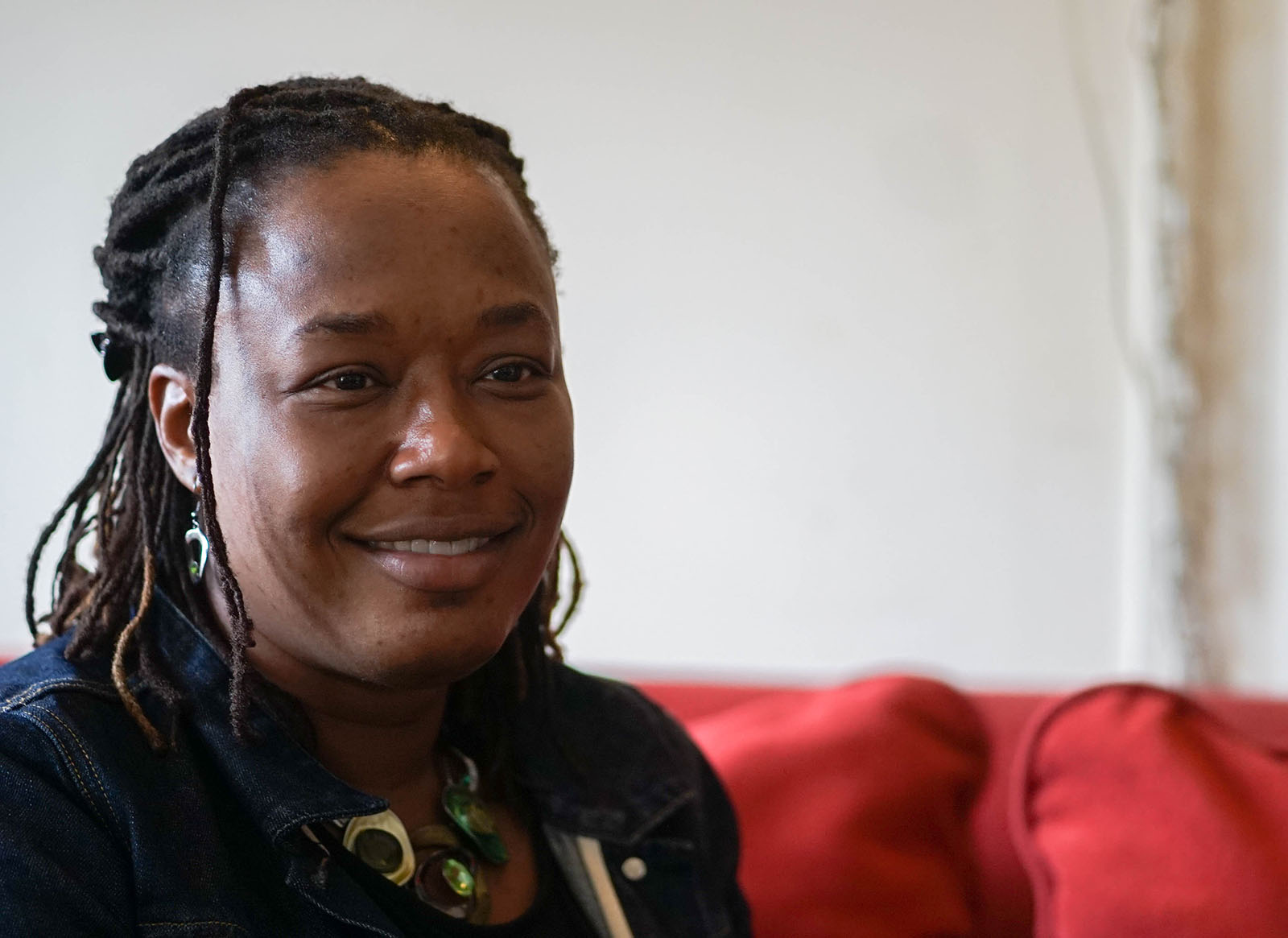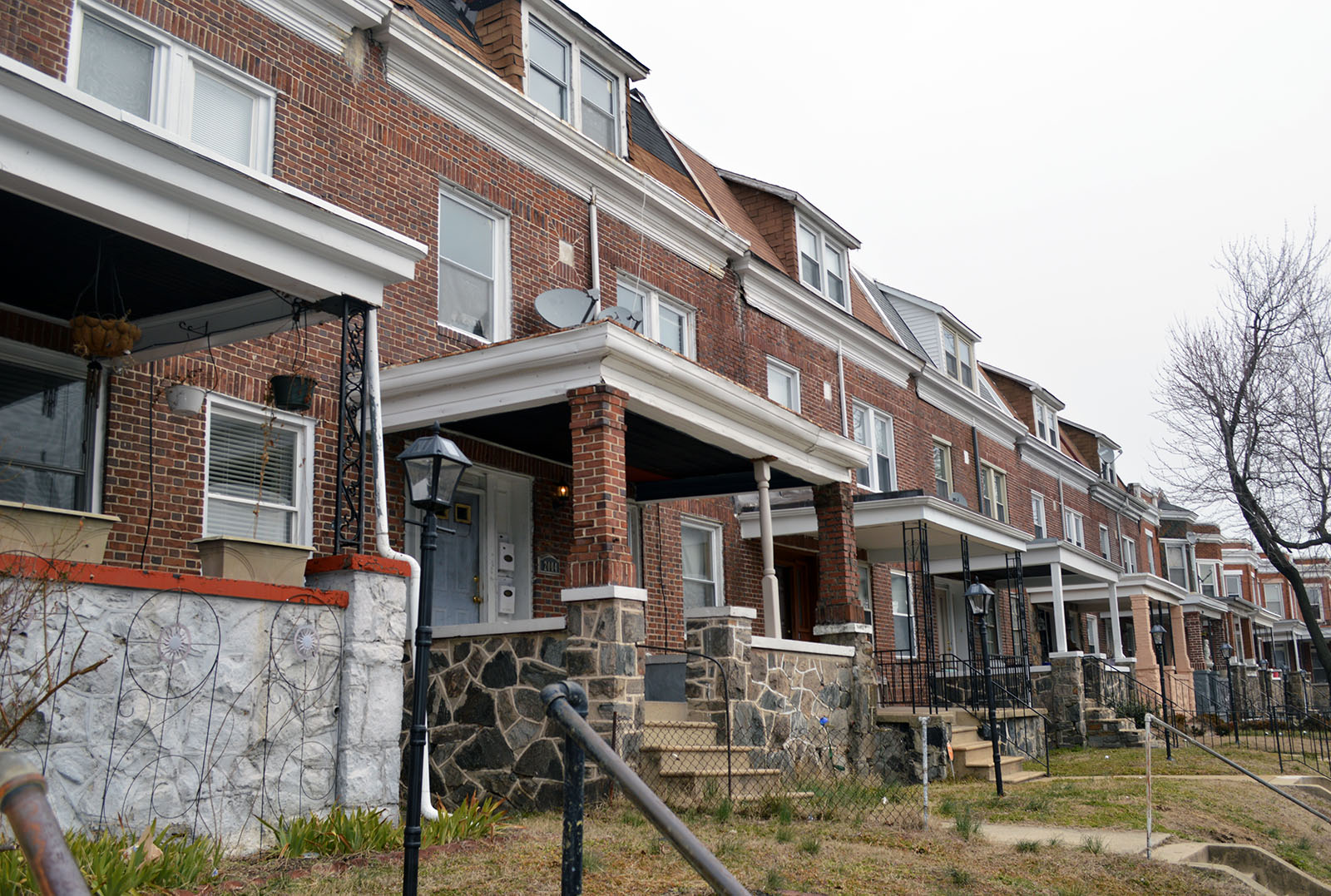
BITTER COLD : CLIMATE CHANGE, PUBLIC HEALTH AND BALTIMORE
For two Baltimore residents, winter is a costly challenge
Keeping the cold out of old Baltimore rowhouses is tough — and expensive, even for homeowners with good jobs. For lower-income residents, paying for needed repairs can eat into funds set aside for heat and hot water. And for people coping with illness, cold weather just compounds their problems. City residents such as Maraizu Onyenaka and Delores Buchanan are just two of the homeowners who have had problems with cold.
When BGE sent a turnoff notice, Delores Buchanan took out a high-interest loan to pay her bills. (Capital News Service photo by Dan Novak)
BALTIMORE — Delores Buchanan, 72, limits going outside when it’s cold. Neuropathy causes her feet to tense up and sting, and cold worsens the pain by reducing blood flow to the hands and feet. It is one of many conditions exacerbated by extreme temperatures.
“I try to avoid really extreme cold conditions because it’s not good for me,” she said. “I try to get someplace warm as soon as possible.”
To soothe the pain in her feet and relax her muscles, she takes hot baths with Epsom salts.
“There’s no better feeling than getting in a hot tub of water and relaxing,” she said. “It just makes my body feel so good.”
Buchanan used to take those baths every night, but now she’s passing on them in an effort to save money. Two summers ago, some pipes burst. The repairs were an unexpected expense, and the flooding caused her water bill to skyrocket. Her April water bill says she still owed $1,186.36.
She missed a month’s payment to BGE and, because she already had been behind on her bills, she received a turnoff notice. “I never had a turnoff notice in my life. I’m going crazy, what can I do?”
“I said, ‘Oh, my Lord.’ Pray pray pray pray.”
She said she took out a $1,500 high-interest loan from a predatory lender, which she expects to pay off by the end of this year.
“I had to take what I could get real fast,” she said.
She tries to manage on about $760 a month from Social Security.
Buchanan owns a 99-year-old, two-story rowhouse in the Oliver neighborhood, on the city’s east side.
The pipes are fixed, but in an effort to climb out of debt, she’s trying to limit how much water she uses. That means she takes her hot bath once or twice a week, usually as a weekend treat, or to loosen up the night before church.
“I can’t afford to keep compiling that water bill,” she said. “It just scares me to death.”
The city’s Department of Public Works estimated the average monthly water bill for a three-person house at $92. That number will increase by 10% a year for each of the next three years and double in 10. Residents already pay about twice what they did nine years ago.
Buchanan’s low income means she’s careful about how much hot water she uses. Because she limits the hot water, she experiences more pain. And because she’s in more pain, she’s unable to work.
She’s spent most of her life in this rowhouse neighborhood near the Johns Hopkins medical campus. According to data compiled by the city’s Department of Planning, Oliver’s population decreased by 24% between 2000 and 2010. In 2010, more than 70% of households in Oliver had incomes below $50,000.
Buchanan was born in Washington and spent much of her childhood in South Carolina. She said that her mother was a “gypsy,” bouncing around the East Coast and Midwest. Her father was never in her life, and she was mostly raised by an aunt and uncle.
She moved to Baltimore as a teenager and found it a “breathtakingly beautiful city.”
She said she worked part-time for 20 years as a personal care provider, a position she said was like being a nursing assistant. She visited homes and assisted people with housekeeping and other daily activities and took them to doctor’s appointments.
Buchanan says her neuropathy keeps her inside on cold days. (Capital News Service photo by Dan Novak)
Buchanan was driving when she experienced the symptoms of neuropathy for the first time. One day, she said, her foot clenched like a fist. She pulled over and had to pry open her toes with her hands.
She had always been athletic — she ran track at Dunbar High School — so she was confused by the diagnosis.
She said she knows some people with diabetes experience neuropathy, but she doesn’t know what caused her condition. “It’s like trying to walk with bricks on your feet,” she said. “It’s not the normal type of movement in the feet.”
On bad days, she doesn’t move easily around the house.
Built in 1920, the house has never been renovated, and she points out repairs that were begun but never completed. The water from the burst pipes severely damaged the kitchen’s wall paneling and flooded the basement. Mold began growing on the kitchen walls, which had to be taken down to the boards beneath. The walls have not been replaced.
"Every time I come in this kitchen it takes my spirit away,” she said.
Her roof needs to be repaired, and she’s hoping a community organization can help her. A leak in her bathroom is causing the wallpaper to peel.
To pay her bills, Buchanan took temporary jobs, including a demanding one that required her to work 12-hour days on her feet three or four times a week. She stayed at the job despite the warning signs her body gave her.
“My inner spirit said, ‘Don’t do it, don’t do it,’ but I was trying to keep this house going,” she said.
While she worked that temp job, she said she wasn’t taking care of herself. She wasn’t eating breakfast and was losing weight.
The work “just tore me down,” she said. “For someone like me it was extremely difficult.”
After working there for a year, she had a stroke in early 2018. She hasn’t worked since, but said she would like an easy job.
Buchanan says her only choice is to sell the house. According to the State Department of Assessments and Taxation, it’s worth $44,000. She said she’s gotten offers as low as $20,000. She wants to move out as soon as possible, but she won’t settle for an offer that low.
“I don’t have the income to stay in my house,” she said. “My back is against the wall and I don’t know what to do.”

“I’ve got to stop paying to heat outside,” Maraizu Onyenaka said as she sat in her rowhouse. (Otto Blais-Nelson, Wide Angle Youth Media)
BALTIMORE — Even when Maraizu Onyenaka sits in her living room with her space heater on, she knows cold air is creeping down the hall, wafting from her kitchen.
“You can feel it,” she said. “If I’m warming this part of the room, I’ll feel a draft coming around the back of my neck.”
It’s the uninsulated kitchen that’s proved to be the biggest problem with keeping her home comfortable since she bought the rowhouse in 2006. Onyenaka, who works as a senior client services manager for IBM, has had four surgeries in five years. And although the cold didn’t worsen her symptoms, it did not help her fatigue, she said. “The cold makes me even more tired.”
“People are on the phone, they’re like ‘Oh, you sound so less upbeat than you usually are,’ and I’m like, ‘Yeah, I’m exhausted,’” Onyenaka said.
Indeed, temperatures in her poorly insulated kitchen varied more than 20 degrees this winter, according to sensors installed in her home by Capital News Service reporters. At 7:34 a.m. on March 9, when the weather station at Baltimore's Inner Harbor registered 37 degrees, the sensor in her kitchen recorded 58.6 degrees — despite her efforts to keep the house warm.
Between March 9 and March 27, temperatures reached as high as 76 degrees and as low as 59 in the kitchen of Maraizu Onyenka's Baltimore row house. Capital News Service measured her home's temperature with custom-built temperature and humidity sensors.
Onyenaka, 41, first came to Baltimore to study history at Johns Hopkins University, from which she graduated with her bachelor’s degree in 2000. The Camden, New Jersey, native saw the “opportunity” in the city, and felt it was a place she could settle into.
“Baltimore is a bigger city [than Camden],” she said. “It has plenty of parts that are not in crisis. And even though this neighborhood is not one of the highest neighborhoods — it’s no Roland Park — it’s not in full crisis. People can live here pretty safely, pretty stably, and there’s a lot of opportunity for recreation and a life.”
After house-hunting for 16 months, she settled on her three-floor rowhouse in the Coldstream-Homestead-Montebello community on 30th Street — a street lined with porch-fronted brown-brick rowhouses — in May 2006. Her first time as a homeowner, Onyenaka planned to live on the first floor and rent out the upstairs space.
When she moved in, she recalled it was particularly hot. But as the seasons changed, she found how cold her house could be.

Rowhouses in the Coldstream-Homestead-Montebello neighborhood were built about 1920.(Capital News Service photo by Dan Novak)
Caulking, lined curtains, frozen pipes
The 1950s-era addition that holds her kitchen lacks insulation and gets far colder than the rest of her home, she said. That has contributed to her monthly energy bills jumping to more than $200.
Over the years, she’s attempted to keep the cold out. “This house is too drafty,” she remembers thinking. “I’ve got to stop paying to heat outside.”
She’s added lined curtains, caulking, spray foam insulation and shades to hold warmth in the old house — but it hasn’t been enough. She hung the lined curtains across the hallway to close off the kitchen from her living room — and though it helped the area get warmer, it also wrought more problems.
“The kitchen would be so cold though, that I was always in fear that I would freeze the pipes,” Onyenaka said. “And sometimes I did. So, I stopped doing that.”
She would roll her space heater first into the bathroom to heat the room until the pipes thawed. When it came time to unfreeze the kitchen, she used the curtain to her advantage — sealing off the area so her space heater could warm it up.
A BGE energy audit recommended nearly $1,700 worth of renovations to batten down the hatches of her 1920 home. If she completed all of them within a year of the audit, which was on January 10, she’d receive a $691 rebate.
But she’s done some research and fears that some of the recommended fixes could create new problems in her old house and not be cost-effective.
She is researching the value of doing all the suggested work, she said. Now, she’s going to focus on the improvements she believes will make the biggest difference, such as insulating the kitchen. She plans to “blow it all out, down to the studs” to hold in heat and renovate it to her tastes.
When it comes to those changes, she said, “I don’t care what it costs — it’s happening.”
Climate change in Maryland is not just about hotter summers. Despite the overall warming trend, expect periods of severe cold in the winter. Read the story.
Cold weather has a profound effect on public health, worsening certain chronic conditions and disproportionately affecting some groups. Read the story.
What are government agencies and institutions in Baltimore and Maryland doing to help people affected by the cold? Read the story.
Stay tuned. During the summer, Capital News Service, NPR and Wide Angle Youth Media will be reporting on the public health effects of climate change during hot weather. Follow the Climate and Health Project blog or sign up for our e-newsletter for details.